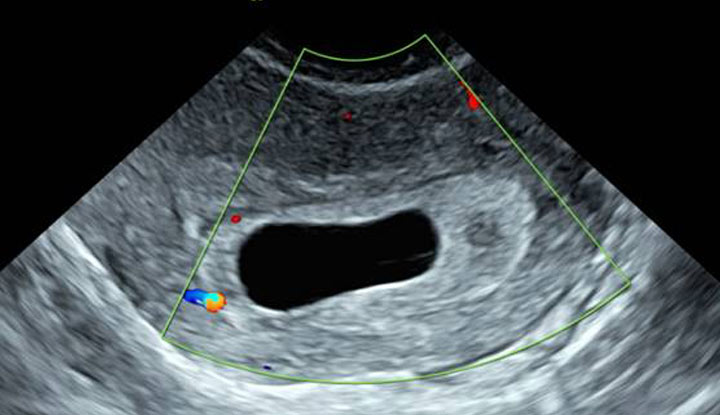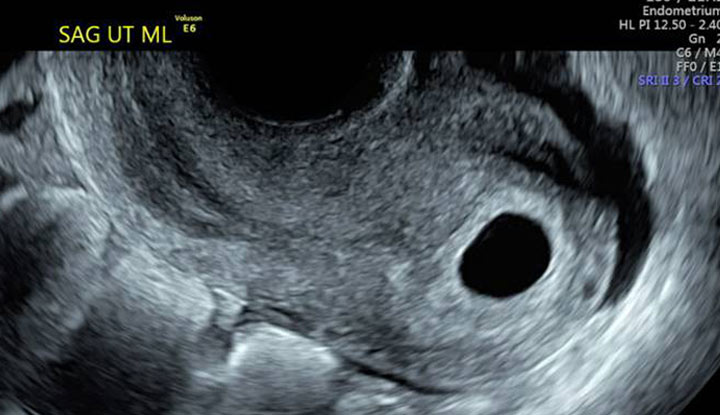A blighted ovum, or anembryonic pregnancy, is when a fertilized egg implants in your uterine lining but doesn’t grow into an embryo. The gestational sac and placenta will grow, but an embryo doesn’t grow so the gestational sac stays empty. It causes a miscarriage in the first trimester of pregnancy.
Advertisement
Cleveland Clinic is a non-profit academic medical center. Advertising on our site helps support our mission. We do not endorse non-Cleveland Clinic products or services. Policy

A blighted ovum (also called an anembryonic pregnancy) is a type of early miscarriage that occurs when a fertilized egg implants into your uterus but doesn’t develop into an embryo. The fertilized egg stops growing, but the gestational sac (where the embryo would develop) continues to grow. The placenta and empty gestational sac will release pregnancy hormones, even without an embryo present. This causes you to have early symptoms of pregnancy or even have a positive pregnancy test. Sometimes, it occurs so early in pregnancy that you don’t know you’re pregnant.
Advertisement
Cleveland Clinic is a non-profit academic medical center. Advertising on our site helps support our mission. We do not endorse non-Cleveland Clinic products or services. Policy
A blighted ovum causes an early miscarriage in the first trimester of pregnancy. During fetal development, a fertilized egg turns into a blastocyte. At around four weeks of pregnancy, this blastocyte implants in the wall of your uterus and develops into an embryo. When you have a blighted ovum, the gestational sac that would hold the embryo continues to grow, even without an embryo present. The following can occur:
A blighted ovum is the No. 1 cause of first-trimester miscarriages.
A blighted ovum can occur so early in pregnancy that you never know you’re pregnant. In other cases, you may experience signs of pregnancy, like a missed menstrual period or a positive pregnancy test. You may have symptoms of early pregnancy, like breast tenderness and morning sickness.
If you have a blighted ovum and experience a natural miscarriage, you’ll have the following symptoms:
Advertisement
The only way to confirm a blighted ovum is through an ultrasound. It will show an empty gestational sac.
A blighted ovum is usually the result of chromosomal problems that occur during cell division. This can happen because the egg or sperm is poor quality or due to an error that occurs at random.
During conception, the egg begins to divide shortly after being fertilized by sperm. Around 10 days later, all of these new cells form an embryo. With a blighted ovum, the embryo never forms or stops growing after it forms. This may be because your body recognizes there is a chromosomal problem and naturally stops the pregnancy from continuing to grow.
Healthcare providers don’t know exactly why chromosomal problems occur during fetal development. But they know certain factors can increase your risk like:
Complications of a blighted ovum are uncommon, but the possible ones could include:
Your healthcare provider will diagnose a blighted ovum using transvaginal ultrasound. This happens in the first trimester, usually between seven and nine weeks of pregnancy. An embryo should be visible at this time in pregnancy.

People are often unaware that they have a blighted ovum. This is because your placenta continues to give off hormones, making your body think you're pregnant. This is also why you can still have symptoms of pregnancy, including a positive pregnancy test.
If you’ve already experienced bleeding or signs of a miscarriage, your healthcare provider will use ultrasound to look at the contents of your uterus.
Some healthcare providers will collect a series of blood samples that check the levels of hCG (human chorionic gonadotropin) in your body. The level of hCG in your blood increases rapidly in early pregnancy and reaches its peak around weeks eight to 10. If it’s not rising quickly or is low, it can indicate a miscarriage or other complication. Your provider may decide to test your hCG levels over the course of several days to evaluate if or how your hCG levels are rising. This can be an effective tool for diagnosing blighted ovum.
Advertisement
The amount of time you can carry a blighted ovum varies. Your placenta will continue to grow and release hormones without an embryo.
For some people, a miscarriage can occur within a few days of a positive pregnancy test. Others may believe they’re pregnant only to discover a blighted ovum at their first ultrasound appointment.
For some people, there may be no treatment needed because your body passes the tissue through your vagina (a natural miscarriage). If you don’t pass all the tissue, there are other options to remove the contents of your uterus. Your healthcare provider will talk you through possible treatments:
Advertisement
A follow-up appointment is usually scheduled four to six weeks after a miscarriage or D&C. You may be given another ultrasound to confirm your uterus is empty. Your healthcare provider will check for signs of infection and make sure there aren’t any complications.
A blighted ovum miscarriage will cause vaginal bleeding and abdominal cramping. A miscarriage usually feels more intense than your regular menstrual period. You can take over-the-counter medicine like acetaminophen to relieve cramping. Avoid lifting anything heavy or any strenuous exercise, as it can increase your bleeding. You may experience spotting for several weeks after a miscarriage.
Recovering from a blighted ovum miscarriage or D&C can last from one or two weeks up to a month. Cramping generally lasts up to a week, but bleeding can last several weeks. Your bleeding should get lighter until it stops completely.
You can resume normal activities when you feel comfortable. Bleeding can increase with strenuous activity or exercise. Hormones may remain in your body and delay your menstrual cycle. Most people will get their period within four to six weeks after a blighted ovum.
It may take longer to recover emotionally from a blighted ovum miscarriage. You may have feelings of sadness, anger or confusion. It’s OK to take time to grieve. Ask your friends and family for support during your recovery.
Advertisement
Most healthcare providers recommend having one or two regular menstrual cycles before trying to conceive again after any type of miscarriage. You should check with your provider before trying to conceive again.
Yes. In fact, most people who have a blighted ovum go on to have a healthy, full-term pregnancy afterward.
Your chances of having another blighted ovum are low. If you experience more than one blighted ovum, your healthcare provider may suggest genetic testing to determine if there’s an underlying cause.
There are no ways to prevent a blighted ovum. Some couples may want to do genetic testing on the tissue inside the uterus. This checks for underlying causes of your miscarriage and can be helpful to couples who have experienced multiple pregnancy losses.
Call your healthcare provider right away if you have any of these symptoms:
Go to the nearest ER If you experience heavy vaginal bleeding — more than two pads per hour for two consecutive hours — or have symptoms of anemia like dizziness, palpitations or paleness.
Losing a pregnancy is upsetting and confusing. Don’t be embarrassed to ask any questions you have. It’s completely normal to have questions and feel emotional during this time. Some questions you may ask include:
Yes, a blighted ovum is a miscarriage. A miscarriage is a loss of pregnancy before 20 weeks. A blighted ovum is considered an early miscarriage because it occurs before 13 weeks of pregnancy.
A blighted ovum isn’t more common with IVF (in vitro fertilization). Your chances of having a blighted ovum with IVF treatment are about the same as they would be with a natural conception.
Losing a pregnancy can leave you with a lot of emotions — and all of them are valid. It can feel especially hard if you go into your first ultrasound with anticipation and instead find an empty gestational sac. When you receive the news, it’s normal to wonder what’s going to happen next.
Trust that your healthcare team is going to take good care of you and recommend the best treatment. If you’re struggling after a miscarriage, speak with your provider so they can recommend support groups or counselors. Fortunately, most people who have had a blighted ovum will go on to have a healthy, full-term pregnancy.
From routine pelvic exams to high-risk pregnancies, Cleveland Clinic’s Ob/Gyns are here for you at any point in life.

Last reviewed on 09/09/2024.
Learn more about the Health Library and our editorial process.